Earlier this week, a judge overturned the transportation mask mandate, which I covered here. I will also be covering the situation in China in its own post.
No one asked this time around, but a friend recommends this P100 mask if you’re looking to go big rather than go home.
The biggest other news is that Omicron continues to cycle into new variants.
- There’s BA.2.1.12, there’s BA.4 and there’s BA.5.
- All seem to be more infectious than BA.2.
- Which was more infectious than BA.1.
- Which was much more infectious than Delta.
- Which was more infectious than Alpha.
- Which was more infectious than the original strain.
We’ve come a long way. China is still attempting Zero Covid, which I will cover in the China post, but that is looking more and more like state failure to adapt to reality than a reasonable policy choice. Covid-19 is here to stay, at least until we can get a nasal vaccine that prevents transmission, research towards which is not currently something we are even willing to properly fund.
Executive Summary
- Moderna booster candidate looks great.
- Cases and deaths radically down on paper due to Easter, mostly ignore.
- Things increasingly returning to normal, travel mask mandates lifting.
- China situation is scary, will be covering that in its own posts.
Let’s run the numbers.
The Numbers
Predictions
Prediction from last week: 250,000 cases (+13%) and 3,900 deaths (-10%).
Results: 231,576 cases (+4%) and 2,402 deaths (-45%!).
Prediction for next week: 277,800 cases (+20%) and 4,100 deaths (+71%!?)
Easter (and perhaps Passover) suppressed cases and somehow even after two years I seem to not properly adjust for such things – but even then, I mean, that death number, come on. When I break things up into regions it seems likely that last week wasn’t getting ahead of itself, and we should expect some ‘catch up’ growth in cases this coming week.
The death count is clearly artificially low, at least in terms of comparing it to expected future calculations, especially in the South. I am anticipating many of those missing deaths being counted in the coming week. There is however also the possibility that this also partly represents the drop-off of ‘legacy’ deaths that are only sort-of Covid deaths, as it is still above 1% of cases reported a few weeks ago whereas the real IFR is going to be a lot lower than that. So it’s not like the number is fully impossible.
I will note that there has been no mention of the decline in deaths among all the people talking about the transportation mask mandate being lifted. Now more than ever, this is not about death.
Deaths

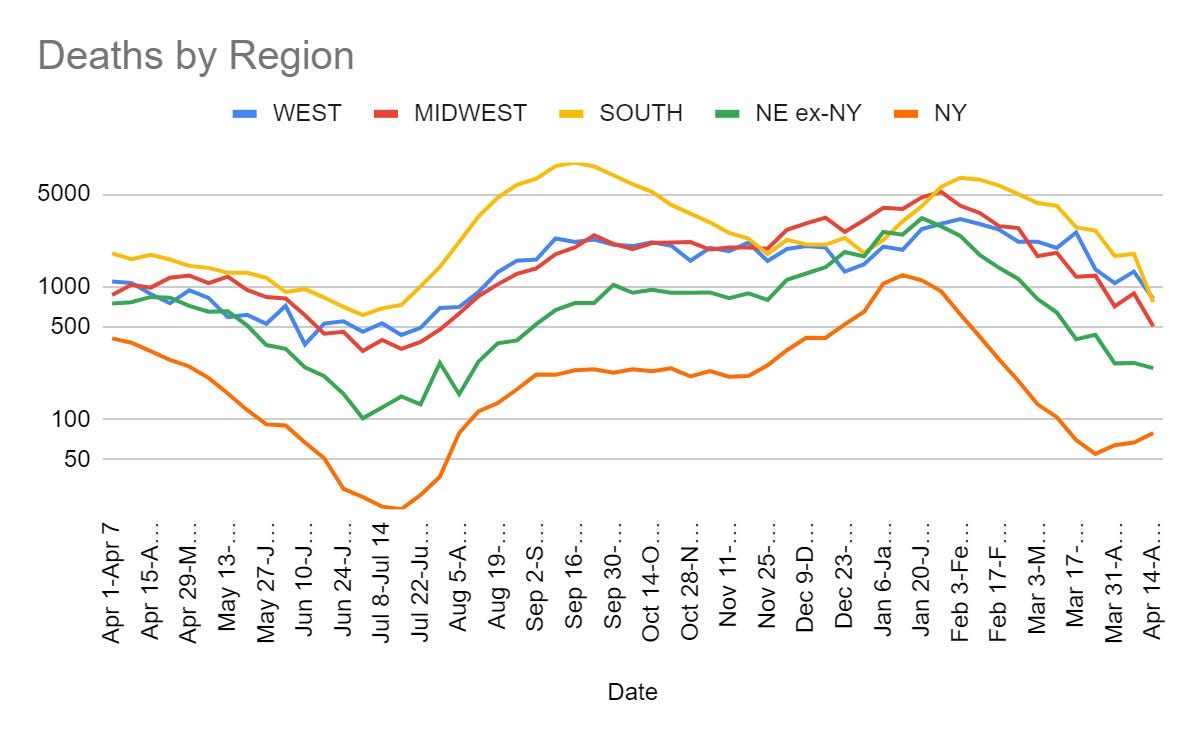
A number of states reported zero deaths. A lot of others had epic drops of more than half.
Cases and deaths in the UK have diverged, which many say is due to the decline in testing.
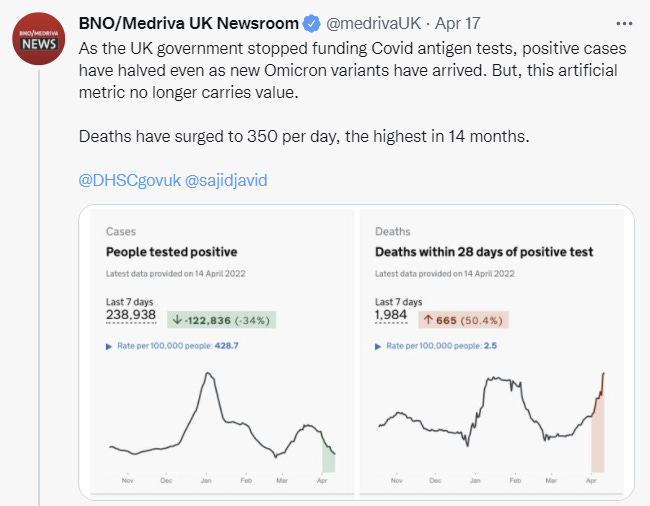
In such situations, the place to look is the positive test percentage.
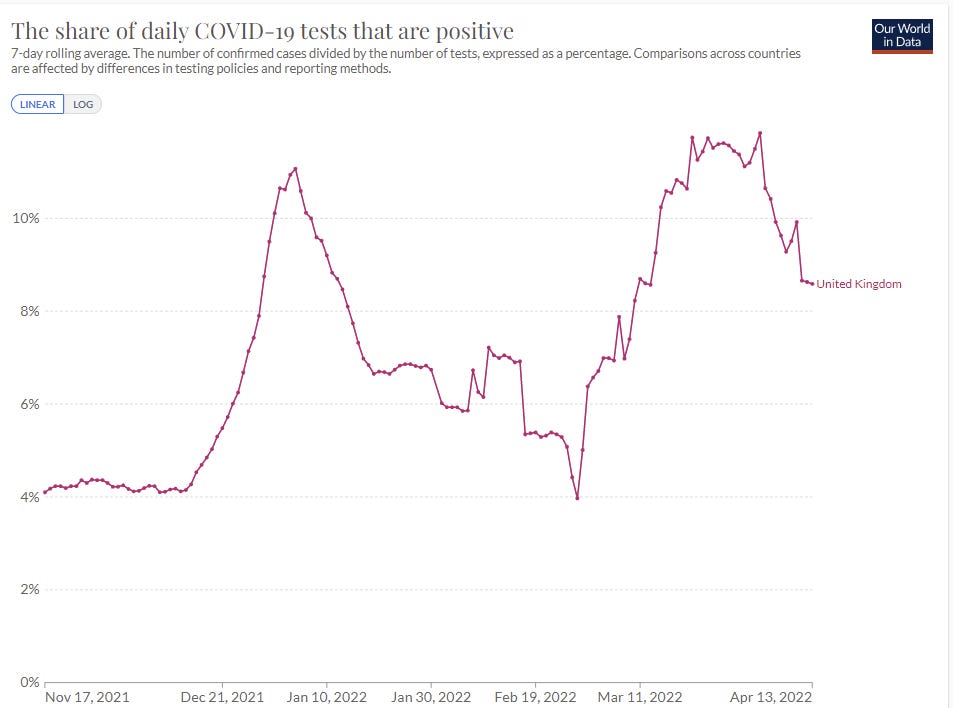
This confirms that the undercount got larger during March before peaking, and there was likely a similar undercount to what we saw in the January peak. Yet the number of cases recorded was far lower while the number of deaths was briefly higher. I do not think the death count was ever actually higher than it was in January, but despite that this is still suggesting that the test percentage stat was underestimating the degree of undercounting.
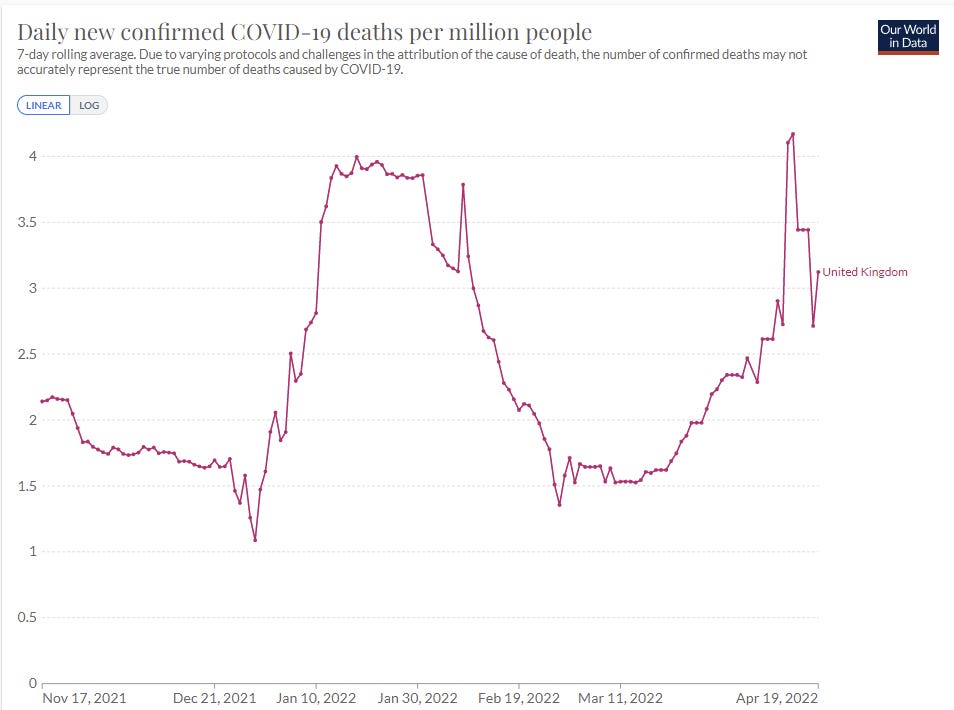

Saying that case counts ‘no longer have value’ seems to me like going too far. It definitely has some value, and especially it has value in relative terms now that we have a baseline for the new policy regime in the UK. What we can’t do is directly compare free-test world to not-free-test world without making the right adjustments.
As always, if you wait long enough, deaths tell the story. The story they are telling is that things in the UK are roughly 75% as bad as they were before. I expect this to start improving again soon. This level of cases simply cannot be sustained for very long. We peaked at over 2,500 recorded cases per million people, which is 0.25% of people per day, almost certainly implying 1%+ of the population per day. That was four months ago. How long, mathematically speaking, could one possibly keep that up?
Cases


At some point I should have looked more into the details of holiday reporting across states and regions and built robust adjustments, but at this point I look at it and it does not seem like a worthwhile use of time. The drop in the South is echoed in deaths so it seems clearly that everyone simply thinks that Easter week is not the time to be tabulating public health statistics.
Either way, seems clear cases should be rising substantially in the coming week.
Physical World Modeling
Moderna has a booster candidate, and it is looking remarkably great. Apologies for the all-caps but this was by far the best source (manuscript), trial design, NIH announcement).

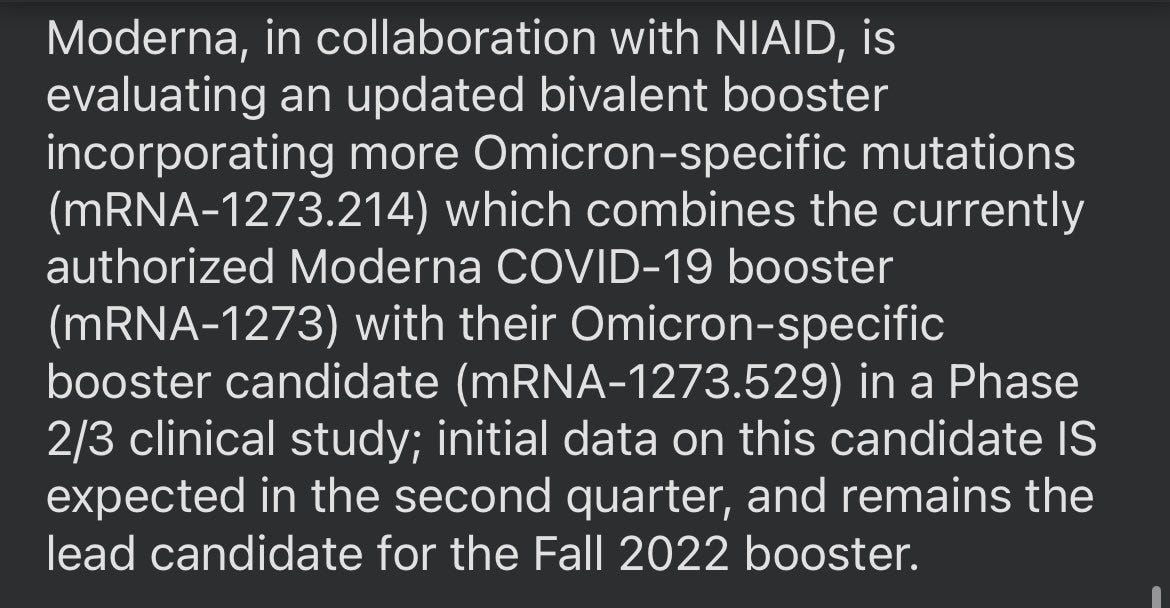
Participants are randomly assigned to one of six vaccine regimens:
- One 50-microgram (mcg) injection of the mRNA-1273 (Spikevax) prototype vaccine, which is the same vaccine currently authorized in the United States as a booster shot for adults
- One 50-mcg injection consisting of mRNA-1273.351 (an investigational vaccine targeting the Beta variant) and mRNA-1273.529 (an investigational vaccine targeting the Omicron variant)
- Two vaccinations administered two months apart: each vaccination is one 50-mcg injection containing both mRNA-1273.351 and mRNA-1273.529
- One 50-mcg injection consisting of mRNA-1273.617.2 (an investigational vaccine targeting the Delta variant) and mRNA-1273.529
- One 50-mcg injection of mRNA-1273.529
- One 50-mcg injection consisting of mRNA-1273 (Spikevax) and mRNA-1273.529The
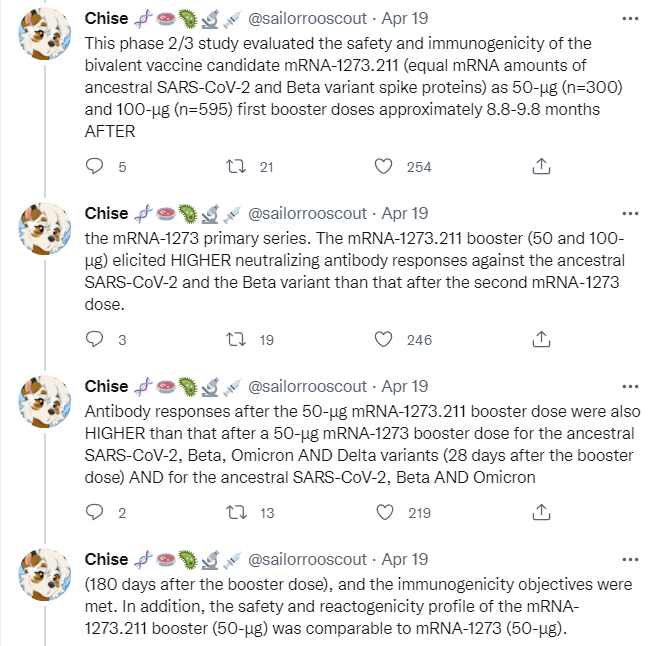
The takeaway, again not that this lasted a minimum of six months:
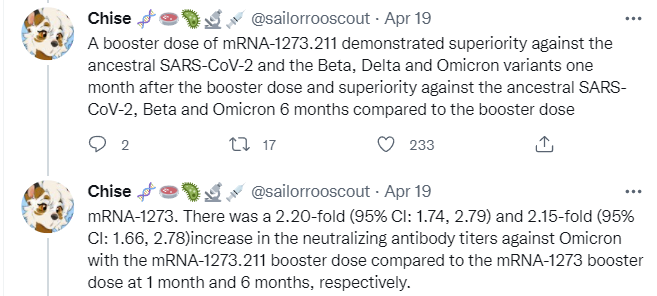

The virus will continue to evolve, but so will our response. Superior boosters are coming, and once again it seems we have an invisible graveyard due to the barriers put in their way but this time the damage is much lower in magnitude. I am not so worried about the medium-term future of the pandemic, leaving more time to worry about the medium-term future of other problems.
About Paxlovid, the drug that cures Covid but which no one can be bothered to take, a reminder.


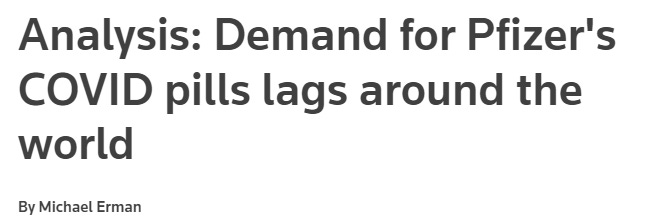
Demand also has been hampered by the perception that Omicron infections are not that severe.
Paxlovid was expected to be a major tool in the fight against COVID after it reduced hospitalizations or deaths in high-risk patients by around 90% in a clinical trial.
…
“We’re just not seeing as many people coming in for testing,” said Dr. Timothy Hendrix, senior medical director of AdventHealth Centra Care in Florida, which has more than 40 urgent care locations.
Hendrix said he had not prescribed Paxlovid in a few weeks. Eligible patients have turned down prescription, because they believe the Omicron variant causes mild illness.
“Most of our patients (say) … ‘I’m just going to go home and tough this out,'” Hendrix said.
We have a drug that has essentially no side effects and cuts down on severe disease and death risk by 90%. Yet most people who get Covid can’t be bothered to take it, and doctors can’t be bothered to fix this or in many cases even know about it.
If I got Covid, I would want to take Paxlovid. It is an important fact about the world that many people do not agree with me and would not want this for themselves.
I can only conclude that most people do not much care about Covid. Which is fair.
And this is despite there being universal overestimationof how dangerous Covid is for most people, which in other circumstances would rightfully be called ‘misinformation.’
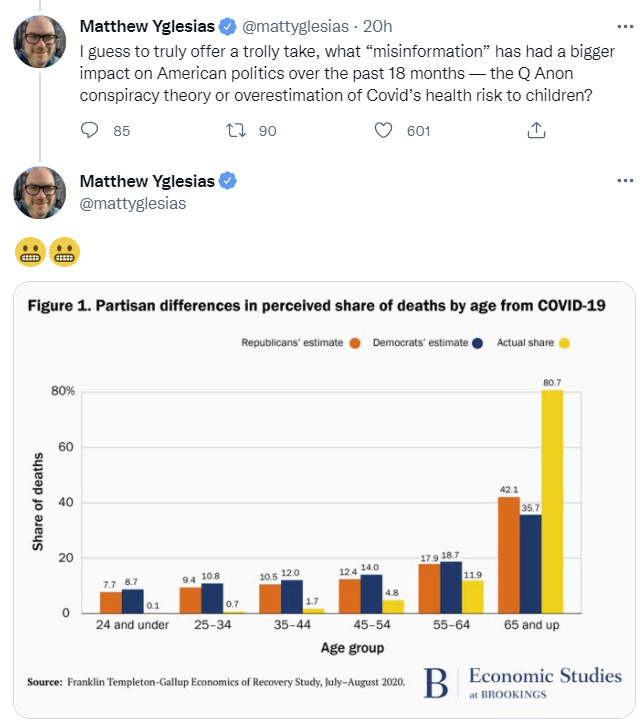
When you listen to debates about risk in children remember that most people overestimate it by something like two orders of magnitude.
BA.1, 2, 3, 4, 5
First there was BA.1, then BA.2 took over in April. Now we are looking at new challengers. In NY/NJ there’s BA.2.12.1.
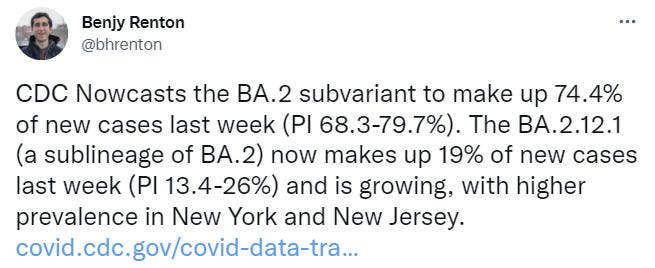
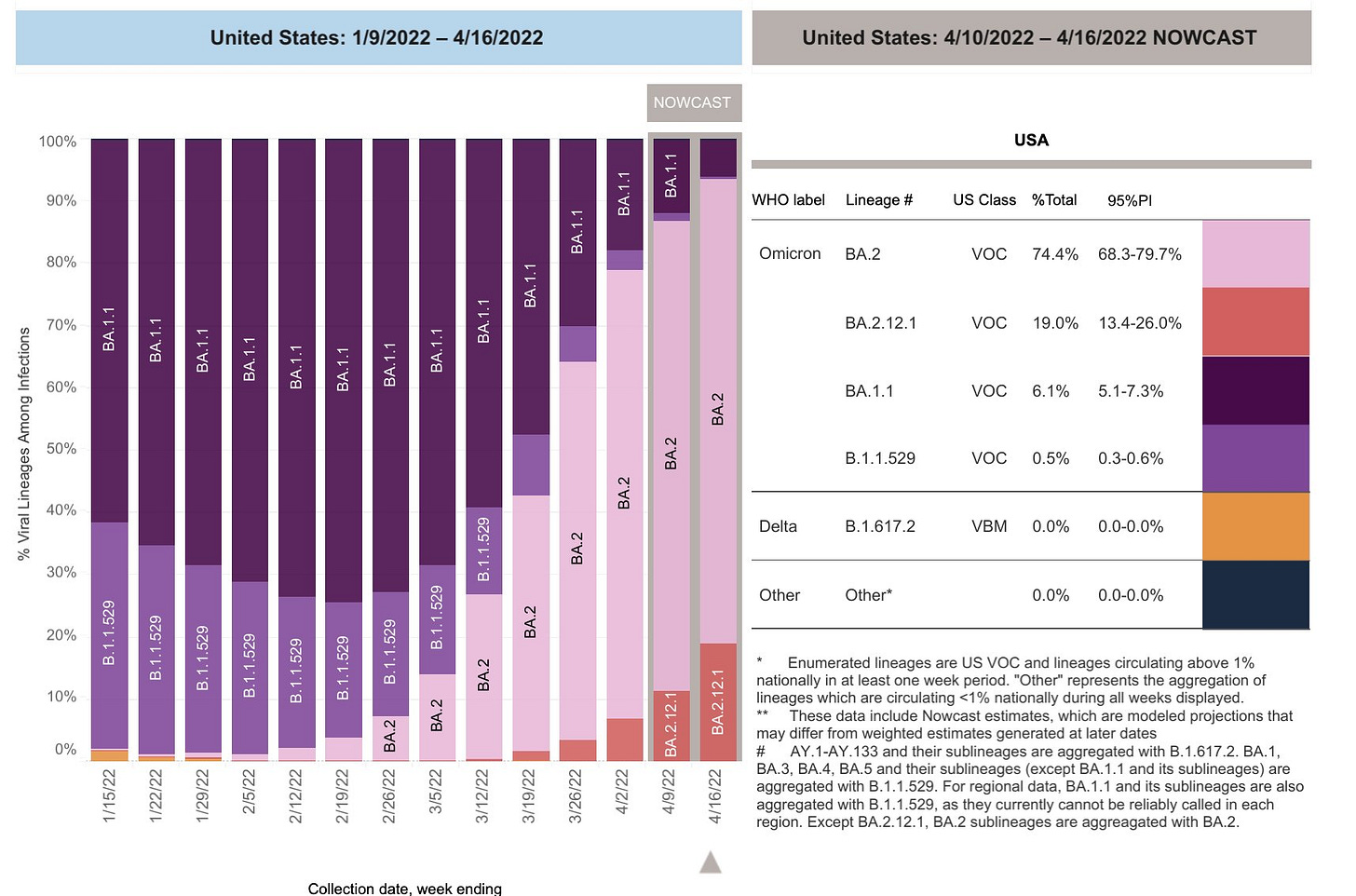
We have seen this movie before. When it happens, the new variant takes over, in this case BA.2.12.1, and for a bit cases go higher.
If we are going to continue to have such ‘resets’ as variant replaces variant, it means that suppression of cases in an area only helps that area in the short-term. Cases you have now and cases you have four months from now have no causal relationship if the variants in question are different, except insofar as the extra cases caused the new variant to come into existence. We are not so much in an ‘equilibrium’ state as we are dealing with a continuous set of very similar but essentially physically distinct pandemics.
Trevor Bedford thread on the various variants and on the rise of BA.4 and BA.5 in South Africa along with BA.2.12.1 in the USA.
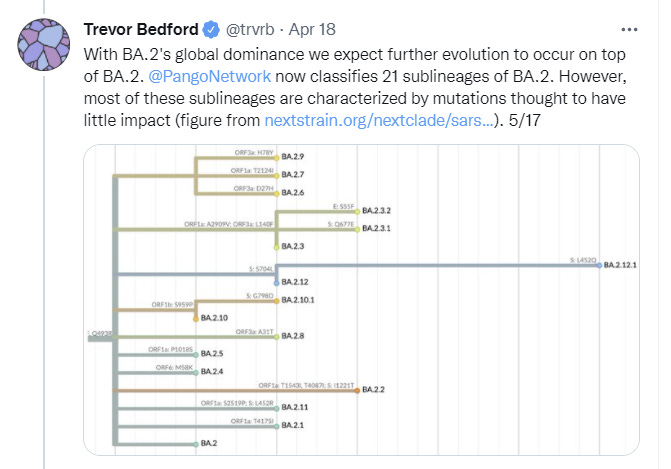
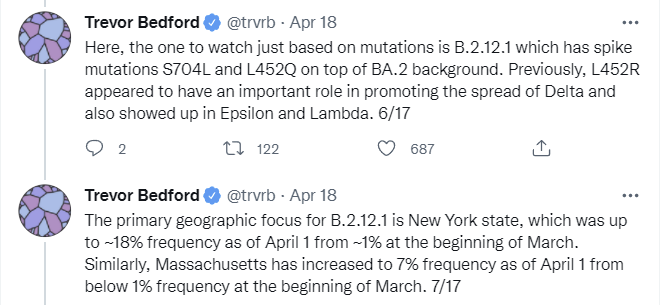


BA.4 being focused on Gauteng definitely raises my ‘this is not a coincidence because nothing is ever a coincidence’ alarm bells, but I will decline to speculate further.
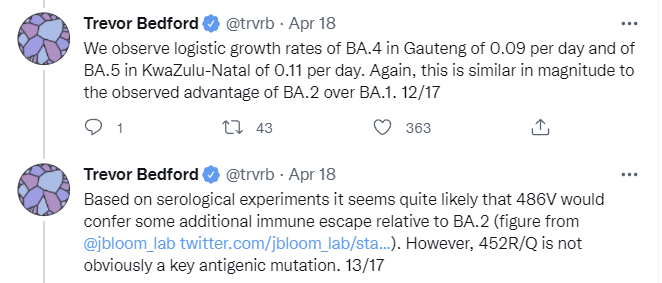
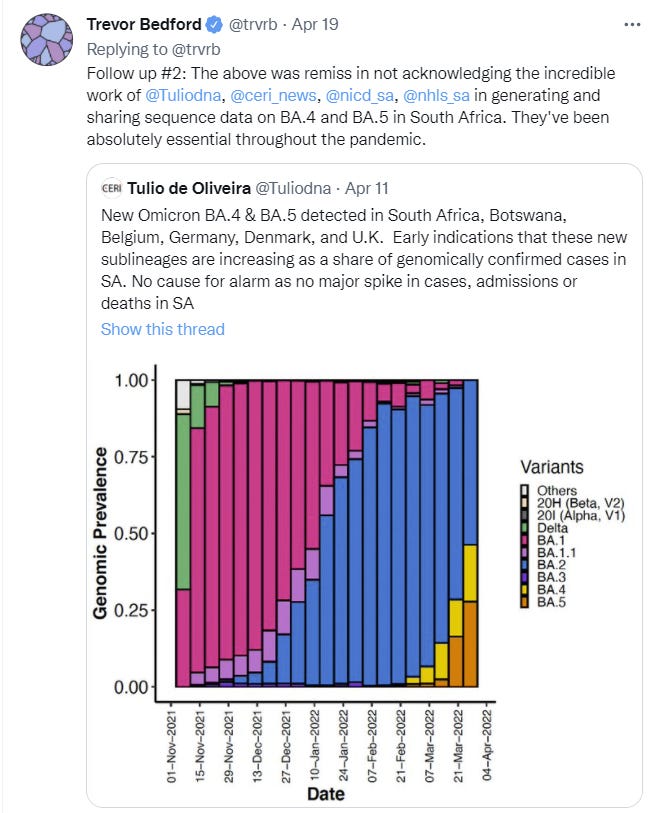
The takeaways from that thread per Scott Gottlieb:

This seems right to me. Omicron spreading more effectively makes it impossible for us to stop it in practice, but that mostly impacts our perception of our ability to stop it since we already couldn’t stop it, which makes that good news. It also confirms that these will be Omicron variants that we can cover with vaccines and won’t create important new escape and likely won’t be all that much more deadly, all of which is straightforwardly excellent news.
Prevention and Prevention Prevention Prevention
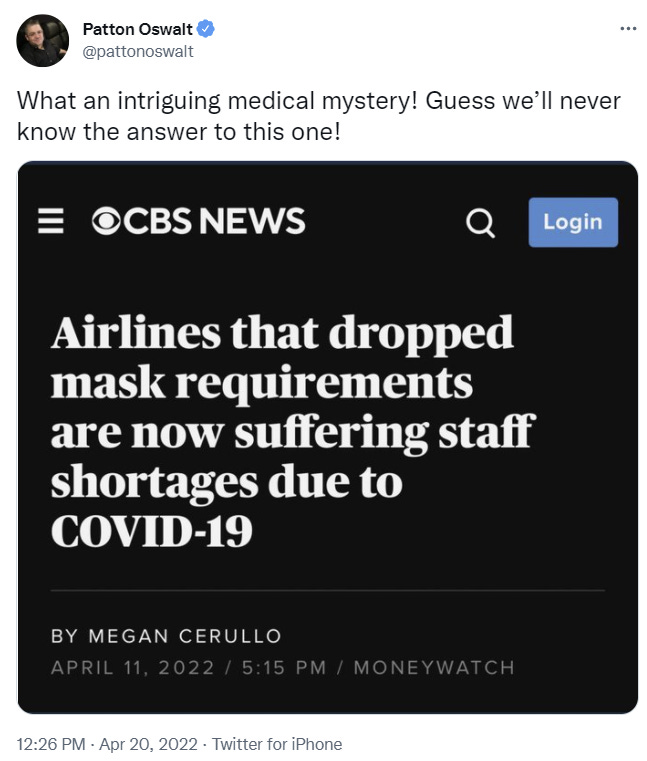
The CBS News article was from April 11. The whole point is that the time spent on airplanes is not when people are at risk, even for airline staff, who got little benefit from the mandate because their risk was in their time inside the terminals. Exactly.
I also keep being amused by the continuous outrage that people might be happy about the whole situation of not wearing masks and be encouraging others to join them, many comments sounding a lot like this.

When someone walking by you casually suggests you can do something you might find more pleasant, that is ‘imposing their beliefs on others.’ I think this is a lot of why such folks don’t see a problem actually imposing their beliefs on others and forcing them to engage in physical actions. They do not see a difference between ‘hey man you’d be better off if you did X’ and ‘do X or else.’
I am curious if there is a way to make such people notice this difference.
The mask story so far, presented in a fashion I can only call ‘tough but fair.’


Nate Silver offers some examples of ways in which we are almost or fully back to normal.

It is early in the season, but it is right after a lockout and also rather cold, so this should fully count.

Air travel should decline somewhat permanently, given the decline in business travel. I am very curious what happens to air traffic now that the mask mandates have been lifted. How many will be afraid to fly, versus how many will be less annoyed to fly? The airlines expect the second effect to dominate, and I do as well, but I am not so confident.
Spain ends its indoor mask mandate except for public transit and healthcare.
A newfound perspective on public health:

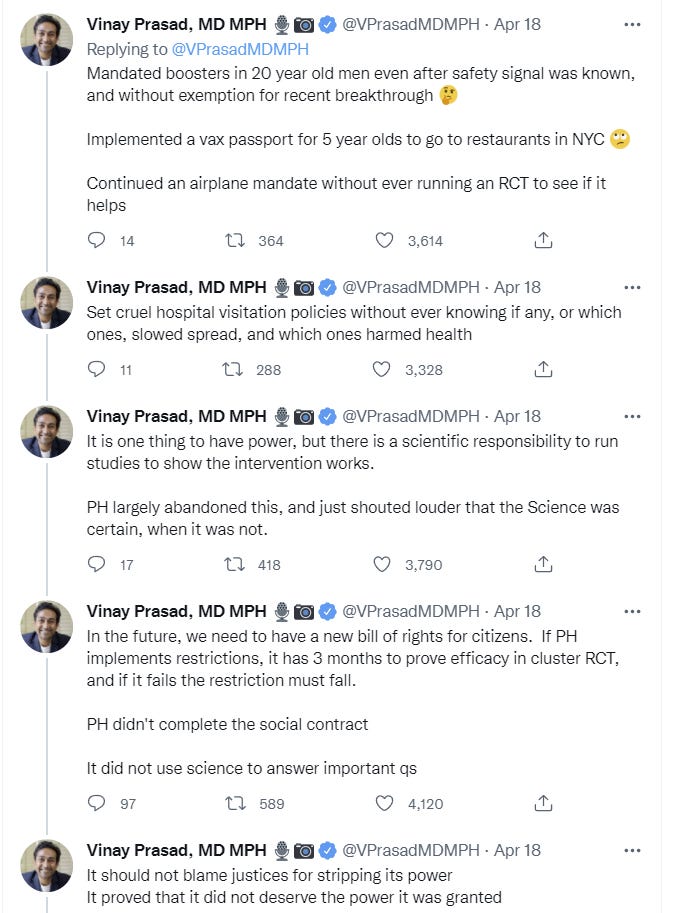

I agree that public health broke the social contract. I do not think public health ever had any intention of honoring the social contract, but even so played its hand quite badly and burned an epic amount of political and social capital on all these fronts and more. Yet that should not cause judges to strip it of power. That is not what judges are here to do. That is what the legislature is here to do. The judges, once again, should not be stripping anyone of power. Either public health officials had the legal authority to do a given thing, or they didn’t. If we still had a nation of laws, not making good decisions would not change that either way unless new laws are passed.
Think of the Children
The joys of honest grading, and a great time to reverse any advice you hear.
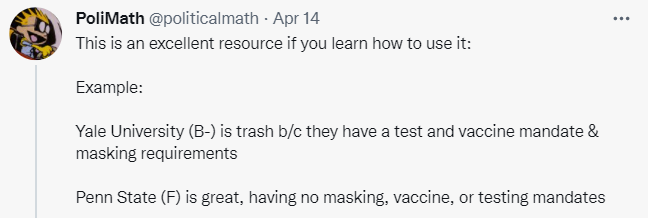
Direct link was blocked, but that originally linked to this resource.

If as Covid Safe Campus does you label no vaccine mandate an F, a vaccine mandate a C and a booster mandate an A, that is not any more or less helpful than going A-C-F instead. This won’t go into your GPA or your permanent record. It is merely convenient shorthand. Partisans know this well. Some people love to see when their representative has a perfect rating from the NRA. Others very much want to confirm someone has a perfectly bad NRA rating, for exactly the same reason.
In Other News
According to poll, our vaccination efforts are so bad that vaccination rates somehow went down. Not that this is physically possible, but still, not a great sign.
Medicare adjusts payments for domestically produced N95s. I am not going to wade through a 1700+ page document to figure out if the changes would actually matter for future pandemic preparedness, and it could easily end up going either way. Favoring American products tends not to be worthwhile, but this could be one of the notably rare exceptions since in a crisis no one is willing to sell to you. What would likely be much more helpful would be removing unnecessary FDA and other barriers to manufacturing our own masks, as that was the biggest barrier this time around, as well as guarding against future Federal banditry (which also happened this time) and making credible promises pay premium prices in a crisis rather than imposing price controls. The best of all would be to get the masks in place in advance via a Strategic Mask Reserve.
Even better than that, we need a program for true mass production of P100 and other superior masks. When the next crisis hits, there is a good chance N95 is not going to cut it, especially in the most dangerous but essential places.
Chris Hobson update thread on the state of NHS. System is under unprecedented pressure, as Covid cases continue to be higher than anyone (including me) expected at this stage, and even though the majority are ‘with Covid’ rather than ‘for Covid’ such cases still need to be isolated and Covid is also still causing staffing shortages. Despite this, work continues on clearing up the years-long backlog. Mostly sounds like everyone is doing their best and remarkably well under the circumstances.
Estimating how many people died due to the FDA delaying their vaccination program. Economic graveyard is bigger still.
Are American institutions unusually bad and thus undeserving of our trust, or are they actually pretty good by historical standards? One can see this either way. It is reasonable to assert that almost all government institutions are horribly broken everywhere at all times, and thus ‘undeserved’ trust in institutions is necessary for institutions to function. Our standards are incompatible with the reality of public choice and the public sector. Then again, they need not stay that way.
To follow up a bit on the transportation mandate ruling’s legal wisdom, here is a detailed post with one perspective. The problem with judges not overreaching in a situation like this is that it does not seem reasonable to say ‘the judge should say that the ruling applies to this particular plaintiff only’ because it is not remotely reasonable to ask each person who desires to not wear a mask to file a year-long federal lawsuit.
Not Covid
Math that Florida finds objectionable (McSweeney’s, remarkably good).
Math in Florida policy might actually have nothing to do with any social justice issues and be purely about corruption? Suddenly only one textbook supplier is available across all of Florida’s K-12 math classes. Never rule out that it might be taxes or fraud.
Biden requiring US-made steel, iron for infrastructure. Both create and kill it with fire. This is not what one does when there are huge problems with inflation and supply chains.

Jerome Adams is so obviously overcompensating for pushing the anti-mask narrative early in the pandemic. He should be ignored just like the other bureaucrats who blatantly lied to the public.
All institutions (not just government) are irreparably broken in one way or another, but it is almost always better to try to fix them than to destroy them and start anew. Maybe “trust in institutions” should be “trust that institutions are making a good faith effort to improve until it’s clear that’s not the case.” “Throw the bastards out” rarely works out the way one wants it to.
Here’s something “not covid,” but that I wanted to share with you… wasn’t sure if you were planning another Ukraine post, so rather than wait for that…
Since your post about current nuclear risks I became more curious about the Keith Payne book “The Fallacies of Cold War Deterrence” cited by Dominic Cummings in support of the view that nuclear deterrence is much less stable than we think and rests on stupid assumptions about adversary psychology. So I gave the book a read this week and checked out some of the references.
The book makes some conceptual points that I think are useful as caveats to the usual theory of deterrence. I don’t think they count as objections to the prevailing school of thought, exactly, unless you turn it into a straw man version of itself (no, I don’t think Schelling et al believed that nuclear deterrence would’ve definitely worked against Hitler–but it is still an important point to note that sometimes a Hitler does come around). That part of the book was clarifying.
But my main goal was to clarify whether the empirical evidence Payne cites supported his contention about the disconnect between US and Soviet war plans, which he states thus (p 25-26):
“Only recently, courtesy of greater access to past Soviet decision-making practices, has it become virtually inarguable that the Soviet leadership never accepted the West’s definition of rationality with regard to nuclear weapons, and that Soviet expectations of US behavior, largely derived from the dogma of Marxist-Leninist ideology, appear to have been a significant factor in Soviet nuclear war planning.”
He refers several times to Soviet plans that “called for very heavy and very early nuclear and chemical strikes throughout Western Europe in the event of war.” (There is a grain of truth to this, but I think you’ll agree with me that it misrepresents his sources in an important way.)
The meatiest English-language source he cites is Heuser, “Warsaw pact military doctrines in the 1970s and 1980s: Findings in the East German archives,” which I hadn’t read before. It is a treasure trove, but it doesn’t say what Payne says it says. Let me quote the abstract, because the difference with Payne’s interpretation of the facts is night and day:
“Paradoxically, while the USSR was deploying more usable and survivable nuclear weapons (the SS‐20), it was developing a strategy which attempted to win a limited war in Europe with conventional weapons only. Pact records do show planning for preemptive nuclear strikes in response to observations of NATO preparations for nuclear launches. Great care was taken not to proceed to a nuclearization of the conflict unless the enemy was about to do so. These planning documents also reveal that the Pact was not expecting to launch all the nuclear weapons at its disposal.”
Essentially, Heuser’s read on the evidence is that for much of the Cold War the Soviets expected NATO to use nuclear weapons 5-6 days into a large conventional war (which was indeed NATO doctrine) and intended to use their nuclear weapons *in counterforce attacks* to destroy NATO nuclear weapons before this could be done. This was because they lacked the ability to gain early warning of NATO intent to launch. To quote Heuser again:
” Consequently, with fewer nuclear weapons at its disposal until the early 1970s than the United States had, the Soviet Union initially had to adopt a nuclear strategy of a massive, simultaneous strike of all forces available to it. Because of the limitations of Soviet abilities to monitor NATO activities, this would have had to be a preemptive strike. Only in the late 1970s did the USSR gradually acquire the technical means required for its preferred strategy, launch-on-warning: this meant Warsaw Pact nuclear release at the moment it became clear that NATO had launched or was about to launch nuclear weapons against the Soviet Union [18].”
By the late 70s, when the Soviets had the technology and capabilities to adopt a more American-style strategy, they did so, contrary to Payne’s claims. For example:
PAYNE:
“NATO policy sought to maintain a lid on the potential for nuclear escalation via sophisticated intra-war deterrence concepts of rational wartime bargaining and limited nuclear war. These US deterrence concepts mistakenly assumed a similarly minded, “rational” opponent, and thus were wholly incompatible with Soviet war plans.”
HEUSER:
“The Warsaw Pact exercise plans, however, confirm the careful analysis of contrary evidence by Notra Trulock, who argues that the Soviet Union did plan also for limited nuclear strikes [87]. Warsaw Pact planning assumed in the late 1970s and early 1980s that there might be several nuclear exchanges, but there was obviously the hope that followon exchanges might be avoidable.”
I went into this willing to update in Payne’s direction, and I think some of his theoretical insights are sound, but I think it became clear from my fact-checking that he misrepresents the empirical evidence about Soviet planning quite badly. The truth is much more complicated than his take, and in some ways contradicts it. I certainly don’t see any evidence that the Soviets were “irrational” by Schelling’s lights. (Castro may have been that irrational, but on the other hand he may have urged a launch knowing that the Soviets wouldn’t agree… kind of like how the Poles lately keep asking NATO to do things against Russia that they know the US will veto, as a sort of brinksmanship virtue signaling.)
I also think it’s reasonable to update in favor of the hypothesis that Cummings is too credulous and willing to assert with great confidence claims from a semi-popular book without checking the references to confirm its key claims.
Insofar as you have the time and inclination to form a more thorough opinion on NATO and Soviet attitudes toward deterrence, I highly recommend the Heuser essay. It’s fairly accessible and the jargon it does use is pretty google-able.
For some reason you keep mentioning p100 as a superior mask model. It is actually only needed if you have various aerosolized chemicals in the air, in machine shops and the likes. For covid protection N100 provides same exact protection, with slightly easier breathing.
How big is the actual difference between the current mRNA vaccines and the nasal vaccine? The mRNA vaccines seem to work against transmission just as well as infection-mediated immunity.
Of course, that doesn’t help you much if it takes a year to update the booster for escape variants (seriously, it looks like its taking more time Omicron discovered->Omicron vaccine than Classic discovered->Classic vaccine).
Now I’m just angry at the world for failing to protect me. But at this stage it feels like things will get worse not better, and liberty is worth the 2% risk of long COVID in the same sense its worth a 2% risk of death or nuclear war or whatsoever.
> When you listen to debates about risk in children remember that most people overestimate it by something like two orders of magnitude.
The first explanation is that most people are innumerate. They have next to no experience with the type of task. They may have made decisions taking into account this information in words of “very low”, or by propitiate-the-gods, etc., but the numbers they translated the words into has no causal impact on their decisions. Remember that a large fraction of people never manage to connect the formal rules of symbol manipulation taught in math class to the real world, and that even many who do still end up disliking math as it was taught to them and thus avoid it.
Also, how did the researchers aggregate people’s answers? Did they perhaps take the arithmetic mean, hm? If they insisted on making figure 1.(!) about two partisan affiliations plus the correct datum, perhaps they should have made a violin plot for each bucket plus a marker for the correct answer, or at least done the usual scientific-paper-plot thing and marked mean+/-std and some percentiles.
> They do not see a difference between ‘hey man you’d be better off if you did X’ and ‘do X or else.’
Process advice as status claim, built around “I know better than you do”. Just as in real terms strangers walking by giving casual advice have terrible SNR because they lack information, in LARP terms it’s insulting/arrogant to assume (…what is expected-cost-benefit analysis, people believe one thing at a time…) that the recipient hasn’t thought of the obvious.
> The first explanation is that most people are innumerate. They have next to no experience with the type of task.
People make hundreds of instinctual or subconscious risk assessments and cost/benefit calculations every day. When most people try to do it consciously, everything goes haywire. It’s like an athlete getting the yips.
Clever post title. XTC “… one, two , three, four, five…”
I wonder: If the FDA had explained from the start that one would be able to unvaccinate oneself later, then there might have been less resistance to the vaccine.
OK you won’t speculate, but do you have some facts about Gauteng. All I know is Johannesburg is there. Is this where omicron was first detected? Nothing po’s me more than the misinformation about covid deaths vs age. I mistakenly had the evening news on last night, then screamed at the TV and shut it off when during a story on airline mask mandates, the anchor man asked ‘what about the five year old children?’. How could the media fail to get this simple fact wrong?
The medias job is not to inform, but for us to consume more media. One way to do that is to scare us… then we pay more attention.
In regards to UK deaths – their excess deaths stats are showing that death levels have been below normal overall and for those 65+: https://www.gov.uk/government/statistics/excess-mortality-in-england-weekly-reports (data up to last week of March, next update is in May). There’s a bit of an increase in younger age groups, but its scale is not significant – and those are likely to be excess deaths for other reasons, such as delayed medical care.
We still need to see the data for April, but if the pattern persists one could argue that all of UK’s COVID deaths are now firmly in the “with COVID” or “even the flu would’ve been deadly” category.
FWIW, I’m glad I went with this respirator. The quick-latch is super-useful – not just for temporarily unmasking, but it helps to put on / take off and it made it easier to filter the exhalation vent. Also, the exhalation vent points downward – this might reduce glasses fog, but I can’t say for sure if I’d have had a problem with any others.
(Cheaper than the one listed in the article, but comes with no filters. It’s probably close in price after buying them separately.)
Do amazon links get filtered out? In any case, the model number is 3M 6503QL
Dunno but I think you posted some sort of preview rather than a link by accident? Never had an issue before.
So, turns out I have COVID. Over the weekend, I got what I thought was a cold, but today I decided I might as well take one of the free rapid tests I’d gotten a few months ago. I’m feeling normal except for a somewhat-stuffy nose and a tickle in my throat (as compared to yesterday, when I had a wildly leaking nose and tickly throat).
I’m ~30 years old and otherwise in good health. Given the low complication rates for my demographic, and how my symptoms are improving, I’m planning to just continue drinking lots of water (and maybe continue using my humidifier) Now With Extra Staying Home. Or, would you say there’s still a good reason to try to find Pavloxid or something similar?
at 30 and healthy with no serious symptoms I think the basic answer is fine. If you have an easy way to do Fluvoxamine and/or Paxlovid I’d take it but I wouldn’t sweat it.
Hey, here’s a bit of good news: Japan’s Shionogi has another COVID-19 antiviral in the same target class as paxlovid that entered Phase 3 with flying colors.
Details are as yet a bit thin on the ground (at least down to the depth I was willing to dig yesterday). But they don’t mention using ritonavir (one of the components of paxlovid that slows breakdown in the liver). If so, then it should have far fewer drug interactions and thus be suitable for many more people to take.
Probable typo. “again not that this lasted a minimum of six months” should probably be “again note that this lasted a minimum of six months”